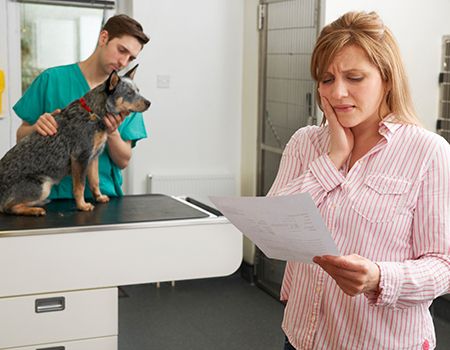Are some of your prices too high?
When clients won't accept your recommendation, could it be time to drop the price? Fetch dvm360 speaker Karen Felsted, CPA, MS, DVM, CVPM, CVA, encourages veterinary professionals to consider cost-based pricing.

Are your prices scaring clients away? Dr. Felsted recommends considering cost-based pricing to help you price products more thoughtfully.A participant at a 2018 summit on veterinary pricing, speaker and practice management consultant Karen Felsted, CPA, MS, DVM, CVPM, CVA, shared lessons at Fetch dvm360 conference in San Diego about how veterinary professionals may not be pricing products and services as thoughtfully as they could.
With many examples in her sessions and from discussions among attendees, Dr. Felsted shared one cogent thought experiment: wellness bloodwork.
Resources on improving the value proposition and pricing right
Stoked by Dr. Felsted's idea? Some resources she shared in her session-free to every curious and inspired veterinary owner, manager and enterprising team member-include:
• Partners for Healthy Pets video about the right-and wrong-ways to explain treatment plans and costs. (Yes, that's Dr. Felsted's cat in the video.)
• Whitepaper from the Veterinary Hospital Managers Association on value-based pricing for veterinary practice (read an overview here)
Is wellness working if no one is buying?
Consider a veterinary practice where most clients are not accepting the recommendation for wellness bloodwork. This is a situation with a product performing poorly in a practice that's not satisfied with growth, not satisfied with revenue and not happy with the low compliance on the bloodwork.
Let's say the recommendation includes a complete blood count, a full panel with 20 chemistries and T4. Could the practice get more pet owners to agree to bloodwork by changing the product-and the cost?
Cost for CBC/chem with 20 chemistries and T4: $57.28
Price charged to client: $152.25
Cost for CBC/chem with 8-12 chemistries and no T4:
$38.26 + $1 supplies + $0 staff time = $39.26
Those are your “hard” costs: lab work and supplies. In the cost-based pricing model for a particular product, you don't include rent and staffing-no hard costs.
What were some 2016 baselines from AAHA reference numbers for this bloodwork?
Practices in the 25th percentile charged $73, the median was $95, the average was $107.57 and the 75th percentile charged $144.
That's a wide, wide range representing many different demographics and communities, but Dr. Felsted said “people mark up work like this by 100% or 150% [by formula].
“But there's no magic in that. That's just something we've done,” she said.
Caveat: Do not apply this cost-based pricing model across the board to everything (you're not including hard costs, like rent and staffing, after all). And it's a poor place to start with a new practice pricing everything for the first time.
“[But] if a lower price will encourage more people to do this, you'll make money off of volume,” Dr. Felsted said. “And that has the advantage that more pets are getting a service that would be good for them.”
Experiment with this cost-based pricing any time you think you have a problem with price, or you want to encourage more clients to get the recommended care for their pets.
Dr. Felsted was not asking attendees to abandon the “gold standard” of medicine and she was not talking about bloodwork necessary for a sick pet. But what's the cost of risk mitigation for wellness bloodwork for a healthy pet?
What's the benefit of “offering more comprehensive wellness bloodwork that nobody accepts?” Dr. Felsted asked. “Be a little more open to pricing things differently,” she advised.